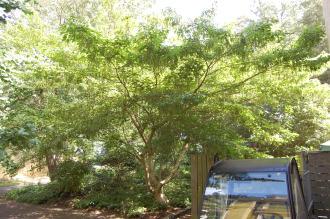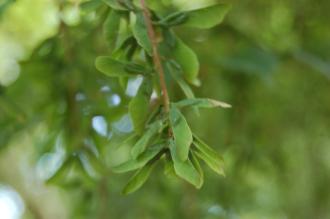
Acer cissifolium (18/07/2015, Kew Gardens, London)
Position: Full sun to partial shade
Flowering period: Early spring
Soil: Moist, well drained
Eventual Height: 10m
Eventual Spread: 8m
Hardiness: 5b, 6a, 6b, 7a, 7b, 8a, 8b
Family: Sapindaceae

Acer cissifolium Leaf (18/07/2015, Kew Gardens, London)
Acer cissifolium is a deciduous tree with a rounded, spreading habit. Its mid to dark green leaves are trifoliate. Its leaflets are ovate with serrate margins up to 8cm long and 4cm broad. Its leaves turn yellow to pink in autumn before they fall. Its gray bark is smooth. This tree is dioecious. Its yellow flowers are small, produced in racemes which are up to 16cm long. Its green fruit is a samara which is up to 25mm long.

Acer cissifolium Bark (18/07/2015, Kew Gardens, London)
Acer cissifolium, commonly known as the Vine Leaf Maple, Vine Leafed Maple, Ivy Leaved Maple or Ash Leaved Maple, is native to Japan. In its native habitat it grows in mountain forests as an understory tree.
The etymology of the binomial name Acer is derived from the classical Latin name for the Maple. Cissifolium is derived from another species of plant Cissus and the Latin folium meaning ‘leaf’.
The landscape architect may find Acer cissifolium useful as a small specimen tree with attractive bark and autumn leaf color.

Acer cissifolium Fruit (18/07/2015, Kew Gardens, London)
Ecologically, Acer cissifolium flowers are attractive to pollinating insects.
Acer cissifolium prefers moist, fertile, well-drained soils. It tolerates most pH of soil although an acid pH is preferred.
Acer cissifolium requires little maintenance. Pruning should be carried out during the dormant months.
Landscape Architecture


